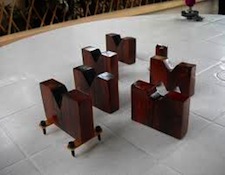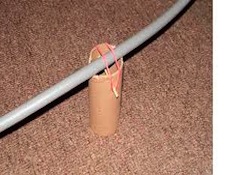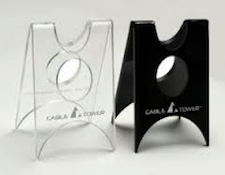It’s the time of year for saving money!
In Part 1 of this article, I wrote about “bare” wires and insulated wires and the fields that are generated, collapsed and regenerated when either of those is used to pass an AC signal. I said that those fields have no dimensions, but only a point of origin, and that they extend from that point forever, diminishing in intensity with distance in accordance with the Inverse Square Rule.
 I also said that radio and television both depend on field effects – specifically that when an electromagnetic field collapses, it will induce current flow in any grounded conductor (a receiving antenna, for example) within its range, and that, because fields extend forever, EVERY conductor in the universe is within any collapsing field’s range. Finally, I reminded you that two of the truly great minds in the history of science, Maxwell and Gauss, had both given us reason to believe that it’s a field, and not the wire, itself, that actually carries the signal “through” a cable; that a cable’s dielectric (or that of any insulated wire) will affect its velocity of propagation; and I tried to show why that effect (and many other changes to the signal carried by a wire or cable) MUST, whether significant or not, come about due, at least in part, to the interaction of one or more fields with the wire or cable’s dielectric.
I also said that radio and television both depend on field effects – specifically that when an electromagnetic field collapses, it will induce current flow in any grounded conductor (a receiving antenna, for example) within its range, and that, because fields extend forever, EVERY conductor in the universe is within any collapsing field’s range. Finally, I reminded you that two of the truly great minds in the history of science, Maxwell and Gauss, had both given us reason to believe that it’s a field, and not the wire, itself, that actually carries the signal “through” a cable; that a cable’s dielectric (or that of any insulated wire) will affect its velocity of propagation; and I tried to show why that effect (and many other changes to the signal carried by a wire or cable) MUST, whether significant or not, come about due, at least in part, to the interaction of one or more fields with the wire or cable’s dielectric.
Now, in Part 2, I’m going to go on to a couple of other things that we know about dielectrics and fields that will finally get us directly to the subject of cable lifters: The first will be another look at the Inverse Square Rule to see how it’s possible for something that spreads through the entire universe to have its most significant effect in just a matter of inches, and the second will be the fact that the dielectric’s effect in changing the cable’s velocity of propagation (and anything else that it might change) is directly proportional to the dielectric constant of ALL of the materials that constitute its dielectric.
 First, let’s look at the Inverse Square Rule: Just to remind you; that rule states that every time you double the distance from a field’s point of origin to the point at which you measure it, you will reduce the measured field strength by a factor of four. (Distance X 2 = intensity ÷ 4) It also works the other way around, so that every time you REDUCE the distance from the source to the measuring point by half, you will increase the field strength by a factor of four (Distance ÷ 2 = intensity X 4). Or to put it most simply, in terms of a field’s ability to affect things and, as we’ll see in just a moment, vice-versa, a thing half as far away from a field’s point of origin will affect or be affected by it four times as much, and a thing twice as far away will be affected by it (or will affect the field) only one-quarter as much.
First, let’s look at the Inverse Square Rule: Just to remind you; that rule states that every time you double the distance from a field’s point of origin to the point at which you measure it, you will reduce the measured field strength by a factor of four. (Distance X 2 = intensity ÷ 4) It also works the other way around, so that every time you REDUCE the distance from the source to the measuring point by half, you will increase the field strength by a factor of four (Distance ÷ 2 = intensity X 4). Or to put it most simply, in terms of a field’s ability to affect things and, as we’ll see in just a moment, vice-versa, a thing half as far away from a field’s point of origin will affect or be affected by it four times as much, and a thing twice as far away will be affected by it (or will affect the field) only one-quarter as much.
Now, let’s consider dielectric constants: Things that don’t conduct electrical energy tend, instead, to store it for later release under the right circumstances. Their ability to do that, expressed as a numerical comparison (a ratio) against a vacuum — the thing with the very lowest energy storage capability possible — is said to be their dielectric constant. The dielectric constant for any given volume of vacuum is “1.0”. The next lowest dielectric constant is 1.00054, for the same volume of air. Always stated per identical volume, the dielectric constants of all other things continue upward from there, with balsa wood and cotton (both increasingly used in High End cable construction), having dielectric constants of around 1.4, PTFE Teflon® coming in at 2.0, polyethylene at 2.2, PVC at between 3.5 and 7.0 (depending on the kind and amount of plasticizers used in making it), and other dielectric materials ranging well into the double digits.
 The importance of this is that, with all fields (except those that are restricted or blocked by, for example, a Faraday cage) extending forever, and with all grounded conductors everywhere therefore falling within their extent, all NON-conductors everywhere must also be considered to be within their extent, too, and thus a part of their dielectric. Now, knowing as we do that the interaction of fields and SOMETHING about dielectrics (probably the electrostatic field surrounding them) can affect a signal carried by a wire or cable, and knowing, further, that the degree of that affect will be determined by both the distance a particular bit of dielectric material is from the source of the field and by that material’s dielectric constant, it makes good sense that we should want to keep only low dielectric constant materials close to our cables and higher dielectric constant materials as far away as possible.
The importance of this is that, with all fields (except those that are restricted or blocked by, for example, a Faraday cage) extending forever, and with all grounded conductors everywhere therefore falling within their extent, all NON-conductors everywhere must also be considered to be within their extent, too, and thus a part of their dielectric. Now, knowing as we do that the interaction of fields and SOMETHING about dielectrics (probably the electrostatic field surrounding them) can affect a signal carried by a wire or cable, and knowing, further, that the degree of that affect will be determined by both the distance a particular bit of dielectric material is from the source of the field and by that material’s dielectric constant, it makes good sense that we should want to keep only low dielectric constant materials close to our cables and higher dielectric constant materials as far away as possible.
That’s why cable lifters.
]]> If you lift your (speaker) cables up just four inches off the floor, that will mean that the first four inches of the dielectric surrounding your cables will be air, and will have a dielectric constant of just 1.00054, and, under the Inverse Square Rule, THAT FIRST FOUR INCHES WILL BE FOUR TIMES AS IMPORTANT IN AFFECTING THE PERFORMANCE OF YOUR CABLES AS THE NEXT FOUR INCHES WILL BE!
If you lift your (speaker) cables up just four inches off the floor, that will mean that the first four inches of the dielectric surrounding your cables will be air, and will have a dielectric constant of just 1.00054, and, under the Inverse Square Rule, THAT FIRST FOUR INCHES WILL BE FOUR TIMES AS IMPORTANT IN AFFECTING THE PERFORMANCE OF YOUR CABLES AS THE NEXT FOUR INCHES WILL BE!
And what will that next four inches probably consist of? Well, at least if you live in the western part of the United States and your house has a concrete slab floor covered with a nylon carpet over foam rubber padding. it will probably be this: about a half-inch of carpet (dielectric constant around 4.0); another half inch(or so) of foam rubber padding (dielectric constant around 1.7), and the next three inches will be the concrete slab, with a dielectric constant of around 6.0. Sound bad? Well don’t worry about it; remember the Inverse Square Rule, and understand that, even though it’s relatively high, the distance of the concrete from the cable makes its effect just a quarter of what it would be if it were even just twice as close. Also consider that underneath the concrete is the rest of the world, and that the dielectric constant of humid earth is 30.0! Be REALLY glad that that’s many times as far from the cable as even the (relatively high, but still much lower dielectric constant) nylon carpeting that, without the cable lifters, your speaker cables would by lying on!
See; now aren’t you glad you’re using cable lifters.
If you’re interested, I published an article about how cable lifters can be made, cheap or free, out of plastic cups. If you ask for it, the publishers might release it again. Also, for all of you that either didn’t try the cable test (Do you remember the one about listening to the same cables both with, and without their jackets?) or never wrote-in to tell about what you heard, that test is about the same thing as cable lifters are; getting poor dielectric materials away from your cables to improve the sound of your system.
Try it, you’ll like it!





